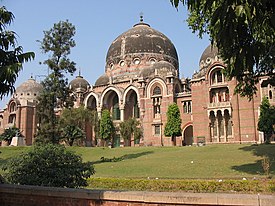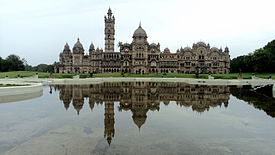Baroda
|
Vadodara વડોદરા |
|
|---|---|
| Metropolitan, Cosmopolitan City | |
| Vadodara | |
  
Nyay Mandir in the heart of Vadodara, Maharaja Sayajirao University of Baroda and The Lakshmi Vilas Palace
|
|
| Nickname(s): Sayaji Nagari (City of Sayajirao Gaekwad), Sanskari Nagari (Cultural City) | |
| Location of Vadodara in Gujarat | |
| Coordinates: 22°18′N 73°12′E / 22.300°N 73.200°ECoordinates: 22°18′N 73°12′E / 22.300°N 73.200°E | |
| Country |
|
| State | Gujarat |
| District | Vadodara District |
| Zone | 4 |
| Ward | 28 |
| Vadodara Municipal Corporation | Established 1950 |
| Government | |
| • Body | VUDA, VMSS |
| • Mayor | Bharat Dangar |
| • Municipal Commissioner | DR Vinod Rao |
| Area | |
| • Total | 225 km2 (87 sq mi) |
| Area rank | 18 |
| Elevation | 129 m (423 ft) |
| Population (2011) | |
| • Total | 2,065,771 |
| • Rank | 20th (3rd in Gujarat State) |
| Demonym(s) | Barodian |
| Time zone | IST (UTC+5:30) |
| PIN | 390 0XX |
| Telephone code | (91)265 |
| ISO 3166 code | ISO 3166-2:IN |
| Vehicle registration | GJ-06 (Urban)/GJ-29 (Rural) |
| Largest city | Ahmedabad |
| Nearest city | Bharuch, Anand |
| Literacy Rate | 94.5% |
| Legislature type | Municipal Corporation |
| Legislature Strength | 84 |
| Lok Sabha constituency | 1 |
| Vidhan Sabha constituency | 13 |
| Climate | Tropical savanna (Köppen: Aw) |
| Planning agency | 1 (VUDA) |
| Distance from Gandhinagar | 126 kilometres (78 mi) NE (Rail & Air) |
| Distance from Mumbai | 395 kilometres (245 mi) S (Rail & Air) |
| Distance from Ahmedabad | 100 kilometres (62 mi) NW (Road) |
| Website | www |
| Population Growth of Vadodara | |||
|---|---|---|---|
| Census | Pop. | %± | |
| 1881 | 101,800 |
—
|
|
| 1891 | 116,400 | 14.3% | |
| 1901 | 103,800 | -10.8% | |
| 1911 | 99,300 | -4.3% | |
| 1921 | 94,700 | -4.6% | |
| 1931 | 112,900 | 19.2% | |
| 1941 | 153,300 | 35.8% | |
| 1951 | 211,400 | 37.9% | |
| 1961 | 295,100 | 39.6% | |
| 1971 | 467,000 | 58.3% | |
| 1981 | 744,000 | 59.3% | |
| 1991 | 1,126,800 | 51.5% | |
| 2001 | 1,491,045 | 32.3% | |
| 2011 | 2,065,771 | 38.5% | |
| source: | |||
Vadodara (Gujarati pronunciation: [ʋəˈɽod̪əɾa]; formerly known as Baroda), the Cultural Capital of Gujarat, is the third largest city in the Western Indian State of Gujarat, after Ahmedabad and Surat. It is the administrative headquarters of Vadodara District and is located on the banks of the Vishwamitri river, southeast of Ahmedabad, 139 kilometres (86 mi) from the state capital Gandhinagar. The railway line and NH 8 that connect Delhi and Mumbai pass through Vadodara.
As of 2011[update], Vadodara had a population of almost 2.2 million+ people. The city is known for the Lakshmi Vilas Palace, the residence of Baroda State's Maratha royal family, the Gaekwads. It is also the home of the Maharaja Sayajirao University of Baroda (Vadodara), the largest university in Gujarat. An important industrial, cultural and educational hub of western India, the city houses several institutions of national and regional importance while its major industries include petrochemicals, engineering, chemicals, pharmaceuticals, plastics, IT and foreign exchange services amongst others.
The first recorded history of the city is that of the early trader settlers who settled in the region in 812 AD. The province was mainly Hindu-dominated with Hindu kings ruling until 1297. The Gupta Empire was the first power in the region in the early years of the Christian Era. Later, the region was taken over by the Chaulukya dynasty. By this time Muslim rule had spread across India, and the reins of power were then snatched by the Delhi Sultans. The city was ruled for a long time by these Sultans, until they were overthrown by the Mughals.
...
Wikipedia

